Lecture 3 - Special Senses - Chemoreceptors
0.0(0)
0.0(0)
Card Sorting
1/67
Earn XP
Description and Tags
Study Analytics
Name | Mastery | Learn | Test | Matching | Spaced |
|---|
No study sessions yet.
68 Terms
1
New cards
What are chemoreceptors?
This is a type of receptor responds to chemical stimuli (ie. odors and flavours).
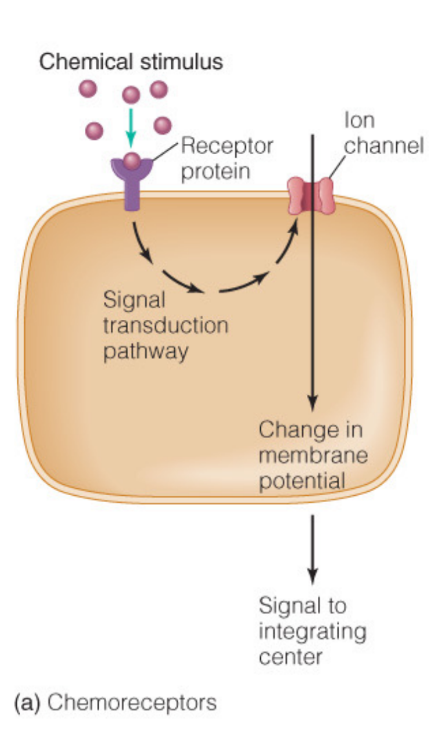
2
New cards
What are the 2 types of chemorecpetors?
Contact and distance.
3
New cards
What are contact receptors?
Taste or gustation.

4
New cards
What are distance receptors?
Smell or olfaction.
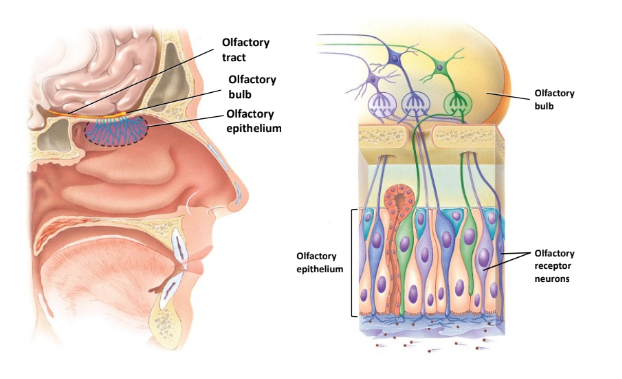
5
New cards
What are the general characteristics of chemoreceptors?
- They are specialized sensory cells that are of neural or epithelial origin.
- Ciliated or non ciliated.
- A chemical signal is able to bind to membrane bound receptor proteins that regulates the permeability of cell membrane.
- Information is transmitted to the cerebral frontal cortex for processing.
- Ciliated or non ciliated.
- A chemical signal is able to bind to membrane bound receptor proteins that regulates the permeability of cell membrane.
- Information is transmitted to the cerebral frontal cortex for processing.
6
New cards
Contact chemoreceptors requires what?
Direct contact (food in mouth).
7
New cards
Chemicals of contact receptors are dissolved in what? And what concentration is required?
Saliva. Requires high concentrations.
8
New cards
Distance chemoreceptors do NOT require what?
Direct contact. These receptors are sensitive and can detect chemicals in the air.
9
New cards
Chemicals of distance receptors are dissolved in what? And what concentration is required?
Mucus. Requires low concentrations.
10
New cards
What are the distinguishing features of distance and contact chemoreceptors? (4)
- Different cell type.
- Different location.
- Different transduction mechanisms.
- Different neural pathways (but coverage on frontal cortex).
- Different location.
- Different transduction mechanisms.
- Different neural pathways (but coverage on frontal cortex).
11
New cards
The olfactory epithelium is what?
The organ of smell in the roof of the nasal cavity.

12
New cards
What type of cell are olfactory neurons?
Bipolar neurons with a thin apical dendrite.
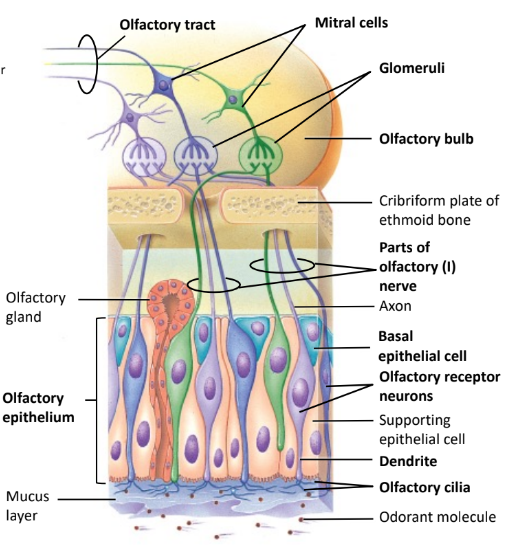
13
New cards
Do olfactory bipolar neurons have cilia or microvilli?
Cilia.
14
New cards
How often to olfactory sensory neurons regenerate?
Every 2 months (approx.).
15
New cards
What are odorants?
Molecules (chemicals) that can be smelled.
16
New cards
For odorants to be sufficient, they must follow what two characteristics?
- Must be volatile (easily vapourized).
- Must be soluble in mucus layer.
- Must be soluble in mucus layer.
17
New cards
What is found on the cilia olfactory receptor cells?
G protein-coupled receptor proteins.
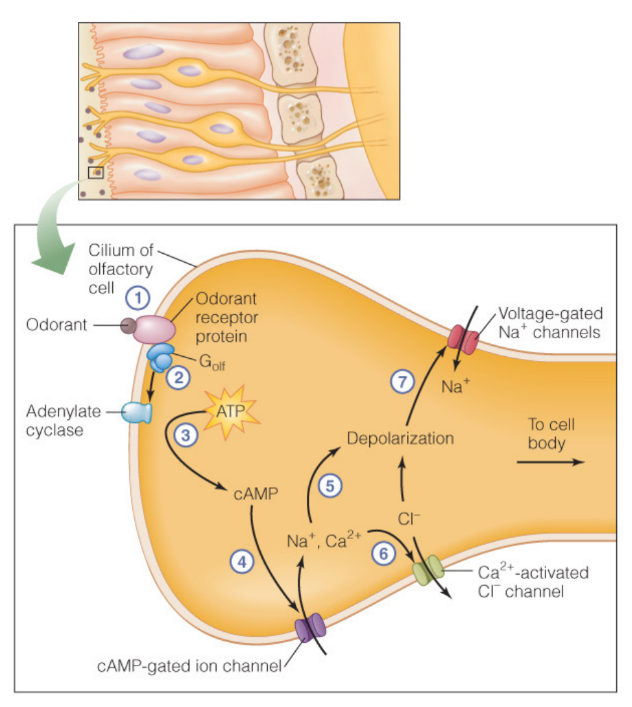
18
New cards
How many genes are found on these g protein coupled receptors on cilia that encode for specific receptors?
~400
19
New cards
In G protein-coupled receptor proteins found on cilia, specificity is relative to the \________ of a receptor to an odorant.
affinity
20
New cards
There is only one receptor type in a receptor cell. This means what?
The binding of one discrete component of an odorant. This means one receptor could be sensitive to conserved parts of different odorants.
21
New cards
Can different receptors detect various parts of the same odorant?
Yes.
22
New cards
Our olfactory system can detect up to how many odorants?
10 000.
23
New cards
How many steps are there in olfactory transduction?
4.
24
New cards
What is the first step of olfactory transduction?
The odorant activates the G protein-coupled receptor.
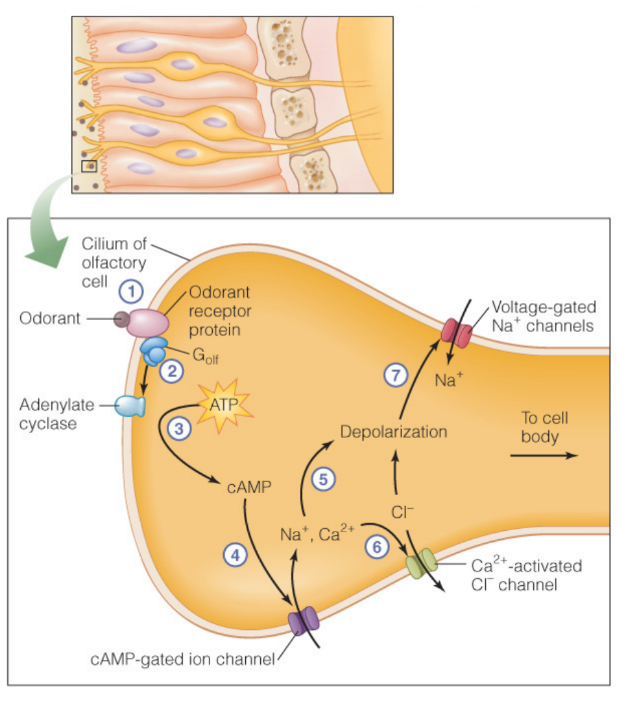
25
New cards
What is the second step of olfactory transduction?
There is an increase of intracellular cAMP (Adenosine monophosphate).
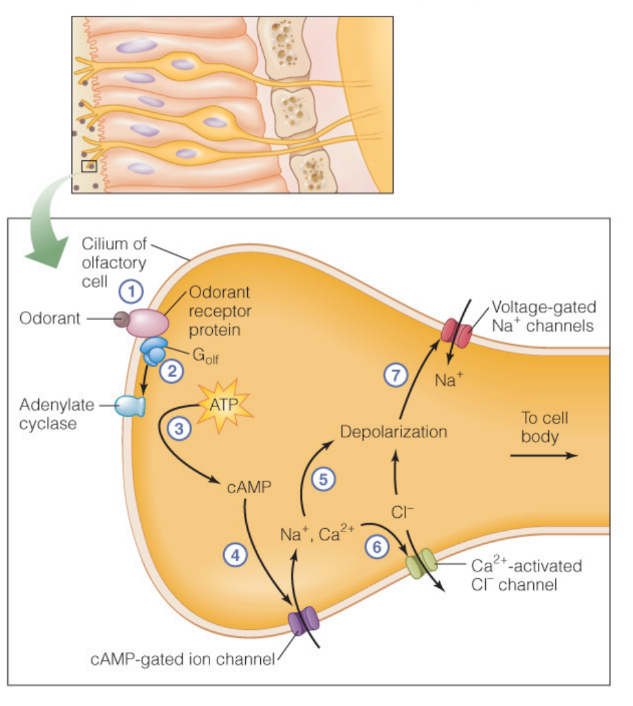
26
New cards
What is the third step of olfactory transduction?
cAMP opens cation channels (Na+ and Ca+) thus causing depolarization (receptor potential).
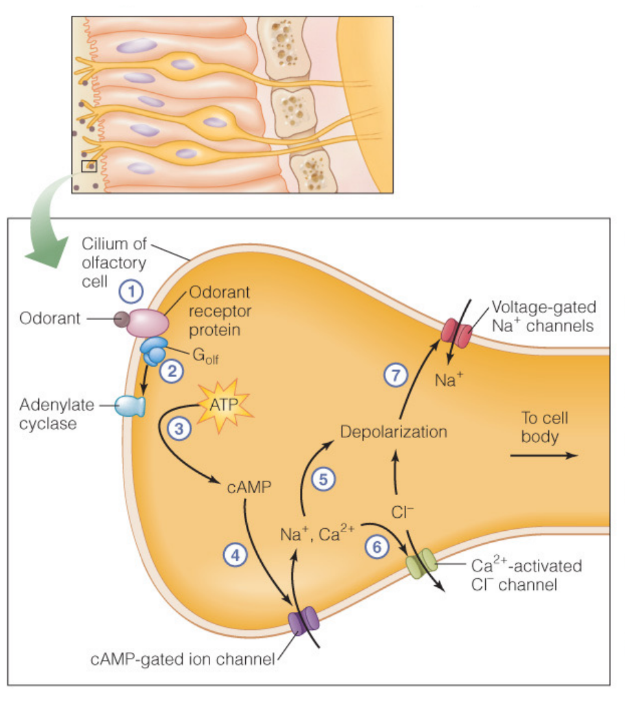
27
New cards
What is the forth step of olfactory transduction?
An action potential is triggered using voltage gated Na+ channels and a message is sent to the brain.
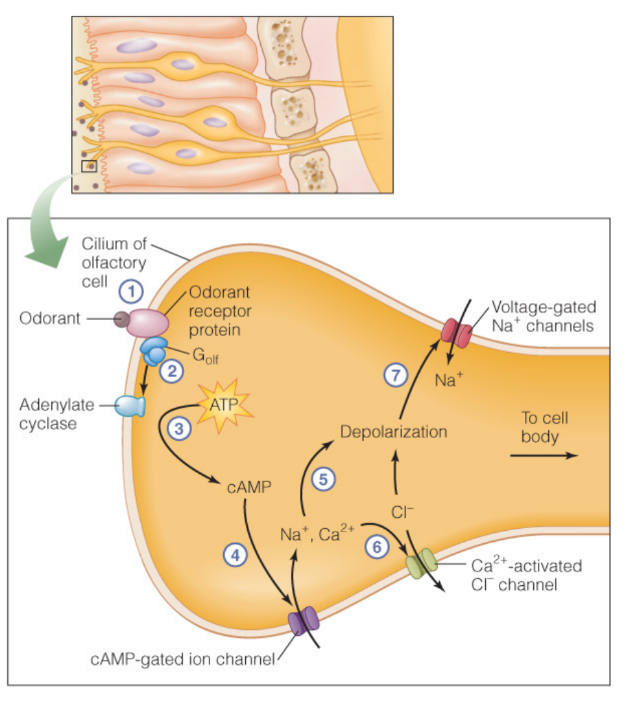
28
New cards
Olfactory adaptation occurs rapidly. When does this mean?
We have the ability to adapt to scents which makes us unable to smell it anymore. (ie. walking into a room that smells like flowers, after a while you will smell "nothing").
29
New cards
What is one odorant that our olfactory system will not get used to and why?
Sulphur because the scent is an indication of danger and so we will continue to smell it.
30
New cards
How are odorants removed?
Through similar detoxification enzymes that are found in the liver.
31
New cards
Describe the olfactory pathway once an action potential is sent.
Olfactory cells will send a message to a glomerus (convergence occurs) which will then send the message to mitral cells. The tracts extend to the primary olfactory cortex in the temporal lobe where the information can be interpreted.
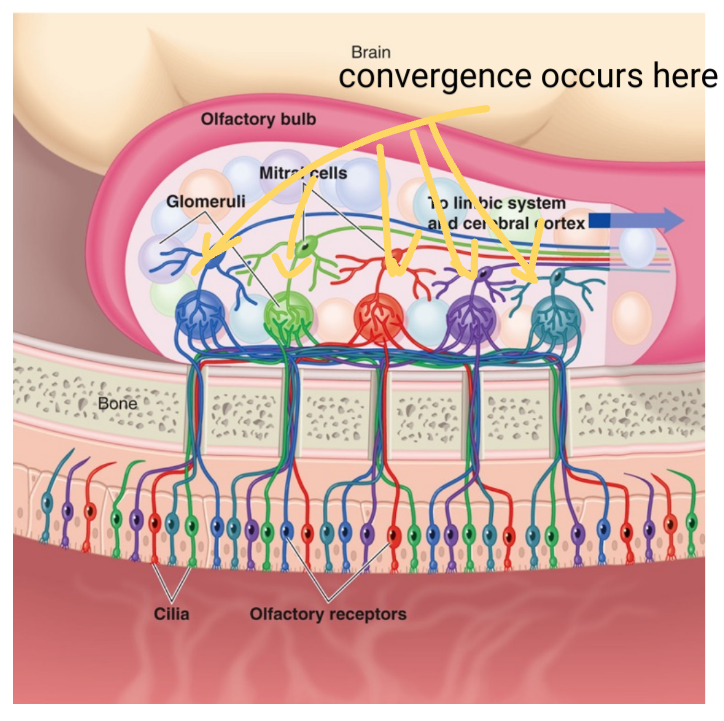
32
New cards
Olfactory tracts that have pathways to the frontal lobe do what with smells?
Interpret and identify the smells.
33
New cards
Olfactory tracts that have pathways to the limbic system do what with smells?
Create an emotional response to smells.
34
New cards
What is gustation?
Sense of taste.
35
New cards
What is the sensory receptor organ for taste?
Taste buds.
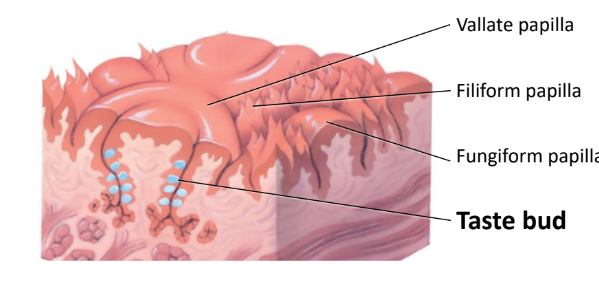
36
New cards
Where are the majority of taste buds located on the tongue?
Within papillae.
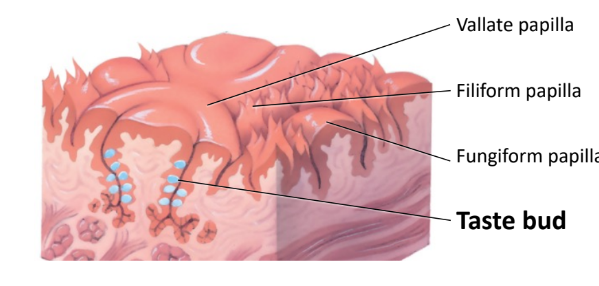
37
New cards
Taste buds consist of what?
Gustatory receptor cells and basal cells.
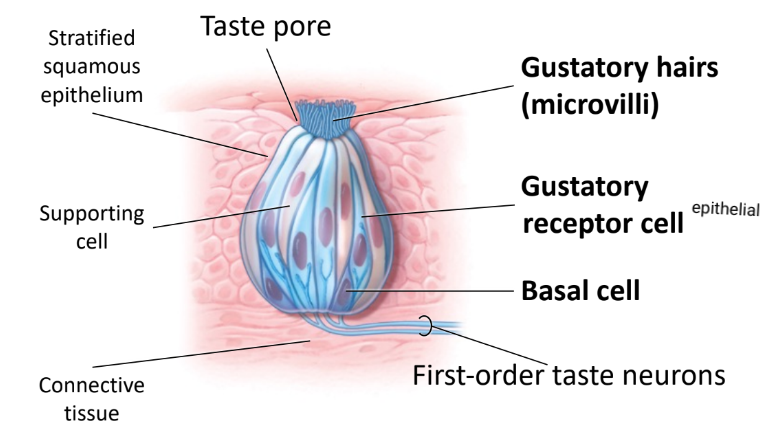
38
New cards
Gustatory cells are of what origin?
Epithelial origin.
39
New cards
Do gustatory receptor cells have cilia or microvilli?
Microvilli.
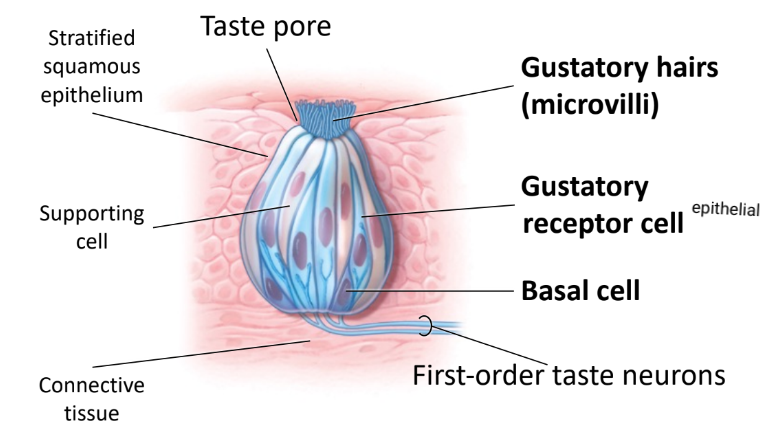
40
New cards
What is the difference between cilia and microvilli?
Cilia are like short, microtubule, tail-like attachments, whereas microvilli are extensions of the cytoplasm (cell membrane).
41
New cards
Where are the receptor proteins of gustatory receptor cells located?
On microvilli.
42
New cards
What wraps around gustatory receptor cells?
Sensory dendrites.
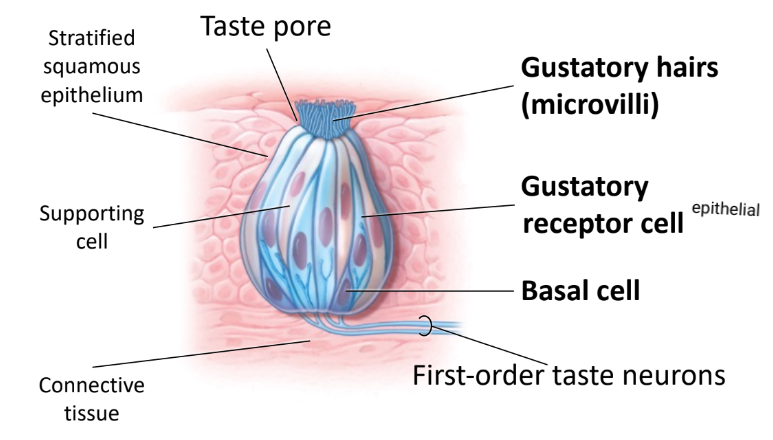
43
New cards
What are basal cells? How often are they replaced and why?
Stem cells. They are replaced every 10 days because they are in direct contact with things (food) that can wear and tear them.
44
New cards
Tastants dissolve in what?
Saliva.
45
New cards
Dissolved tastants enter the taste bud through what?
Taste pores.
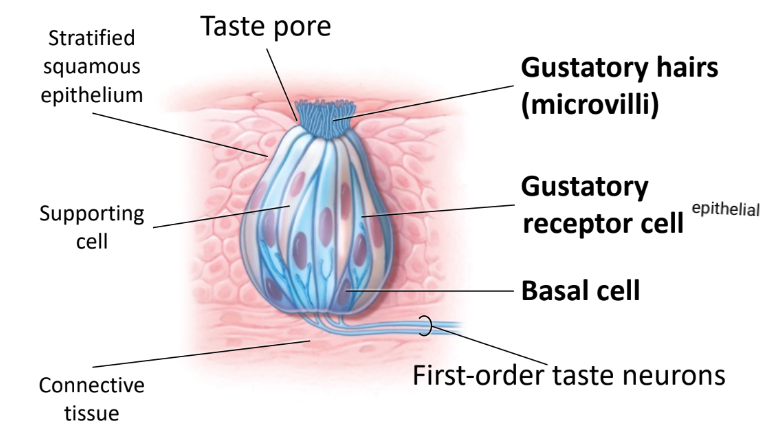
46
New cards
Taste receptor proteins are found where?
On the apical surface of taste receptor cells.
47
New cards
What are the three types of proteins and intracellular signals that taste receptors have?
1) Na+ channel.
2) Proton (H+) channel.
3) G protein-coupled receptors.
2) Proton (H+) channel.
3) G protein-coupled receptors.
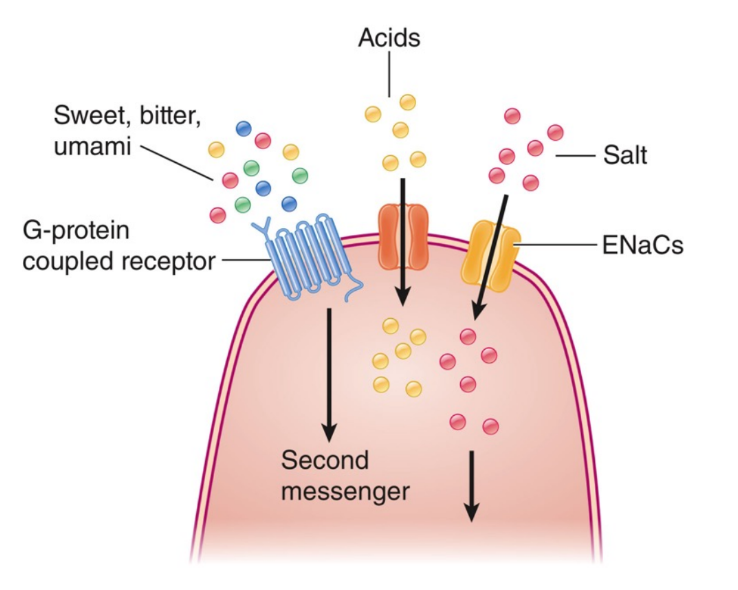
48
New cards
The Na+ channel lets us detect what taste?
Salty.
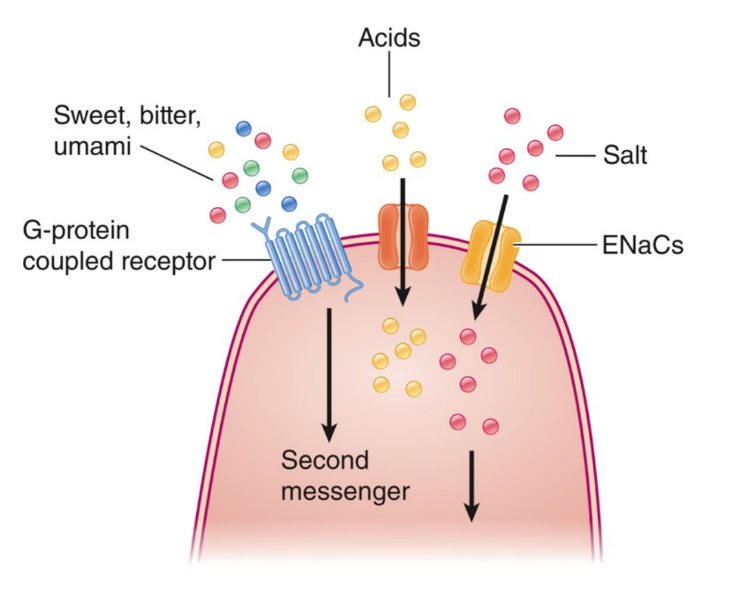
49
New cards
The Proton (H+) channel lets us detect what taste?
Sour.
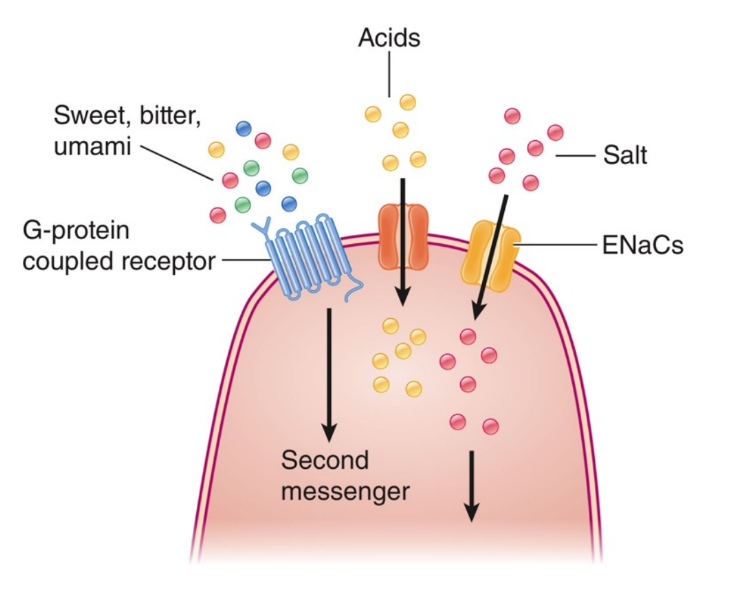
50
New cards
The G protein-couple receptors lets us detect what tastes?
Sweet, bitter, and umami.
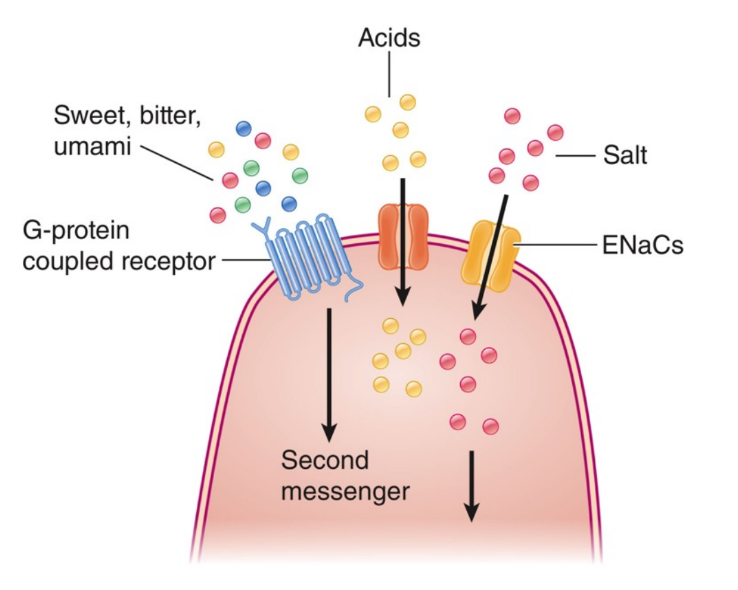
51
New cards
Na+ and proton channels create a direct stimulus because?
Na+ correlates to salty and H+ correlates to sour, so when these things enter through the channel, they cause depolarization and thus an action potential is sent regarding what taste is sensed.
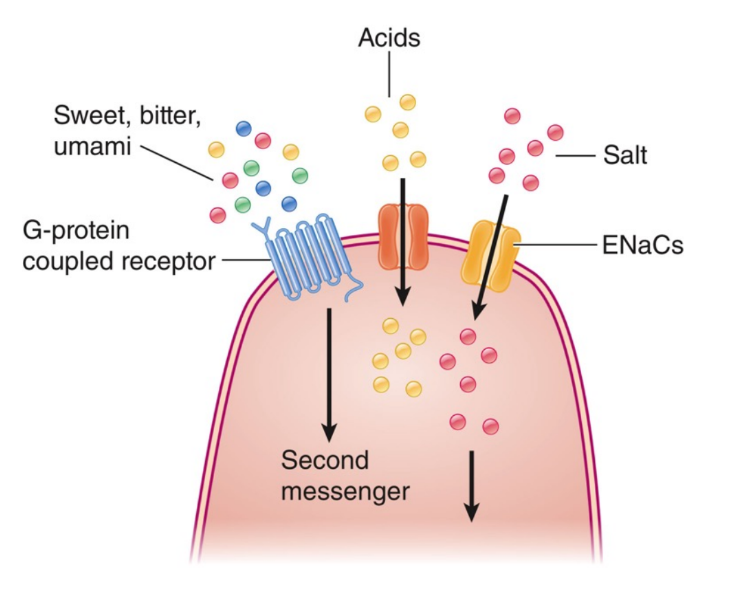
52
New cards
Describe how G protein-coupled receptors work in gustation.
The receptor gets activated by the tastant, causes a receptor potential which causes an increase in intracellular Ca+, thus triggering neurotransmitter release which will act on a sensory neuron and create an action potential.
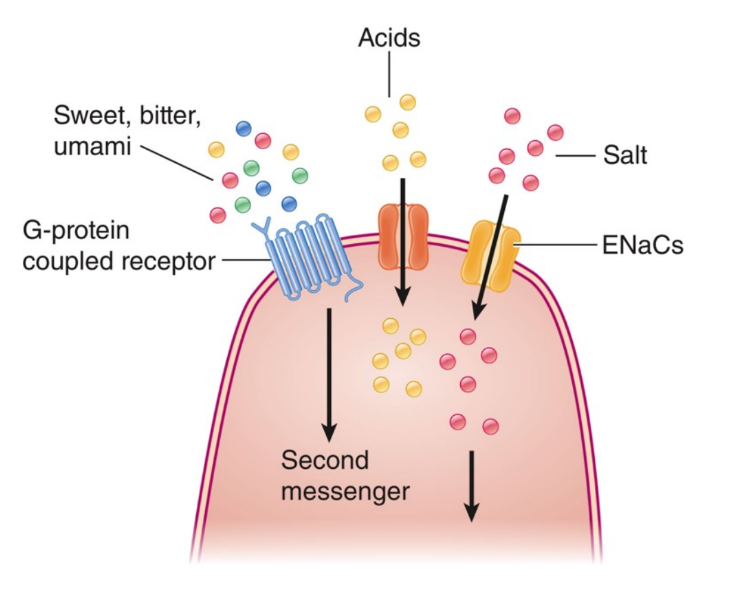
53
New cards
Thresholds of activation vary by gustatory cell (primary taste). Which are the most sensitive and which are the least?
Bitter receptors are the most sensitive, whilst salty/sweet receptors are the least sensitive.
54
New cards
Why are bitter receptors more sensitive?
Because things that are typically dangerous for us to consume are bitter.
55
New cards
Complete adaptations of tastes occur within how many minutes? Using what mechanisms?
1-5 minutes using intrinsic and extrinsic mechanisms.
56
New cards
What three cranial nerves are involved in gustation?
Facial (VII) nerve, Glossopharyngeal (IX) nerve, and Vagus (X) nerve.
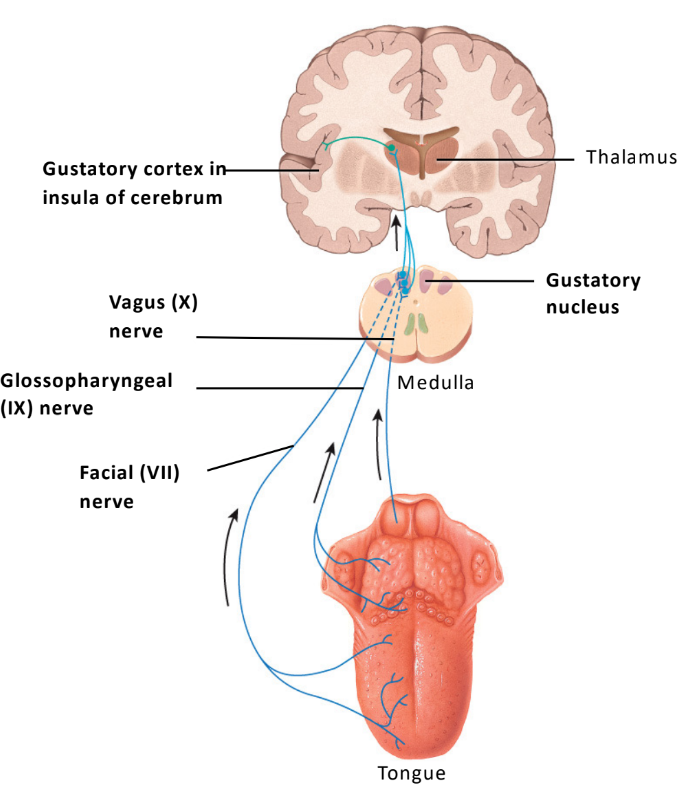
57
New cards
The cranial nerves innervate the \_______ \_________.
Medulla oblongata.
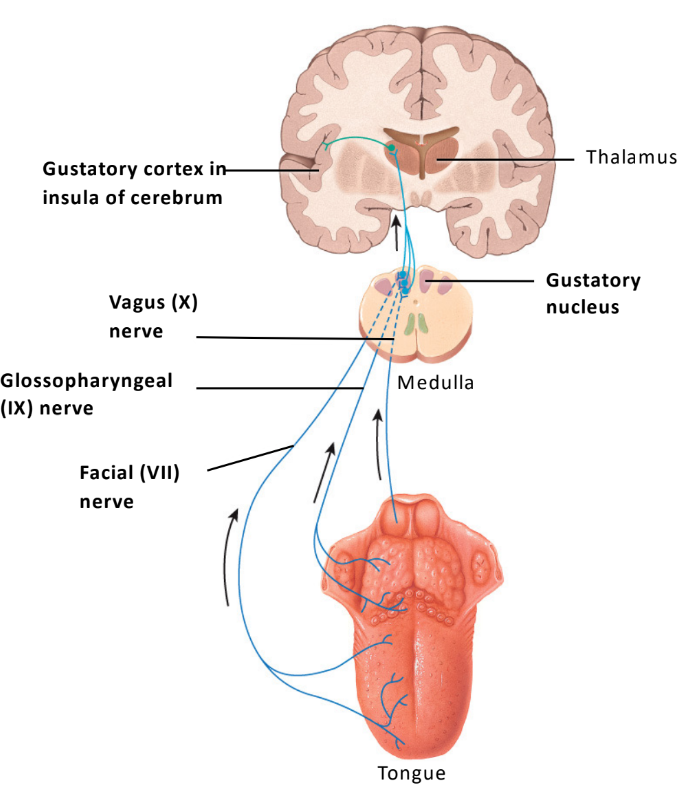
58
New cards
Pathways from the medulla oblongata to the limbic system and hypothalamus create what?
An emotional response to taste.
59
New cards
Pathways from the medulla oblongata to the thalamus and then to the gustatory cortex in the insula of the cerebrum create what?
A conscious perception of taste.
60
New cards
Taste is strongly influenced by what?
Smell and stimulation of thermoreceptors, mechanoreceptors, and nociceptors. This is why nose blockage causes food to taste bland.
61
New cards
Olfactory sensory receptor cells are of what origin?
Neural.
62
New cards
Gustation sensory receptor cells are of what origin?
Epithelial
63
New cards
Catfish have how many taste buds?
180 000.
64
New cards
90% of the 180 000 taste buds are what?
Extra-oral.
65
New cards
Humans have how many tastebuds?
10 000.
66
New cards
Catfish use extra-oral taste receptors to detect and capture what?
Foodstuffs.
67
New cards
Facial taste system has high sensitivity and uses what?
The IX and X cranial nerves to vagal lobe of medulla.
68
New cards
Extra-oral system has less sensitivity and uses what?
VII cranial nerve to facial lobe of medulla.